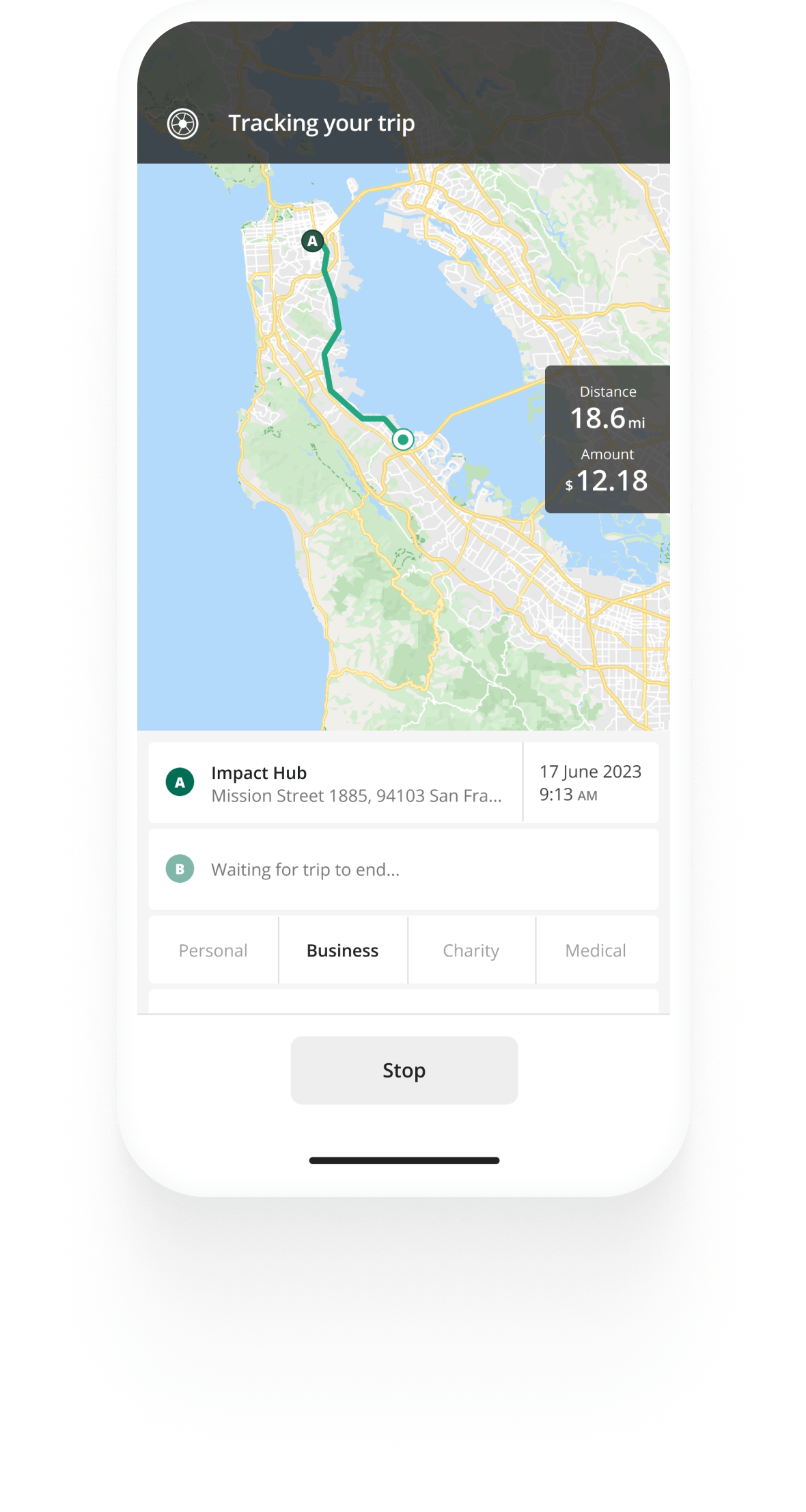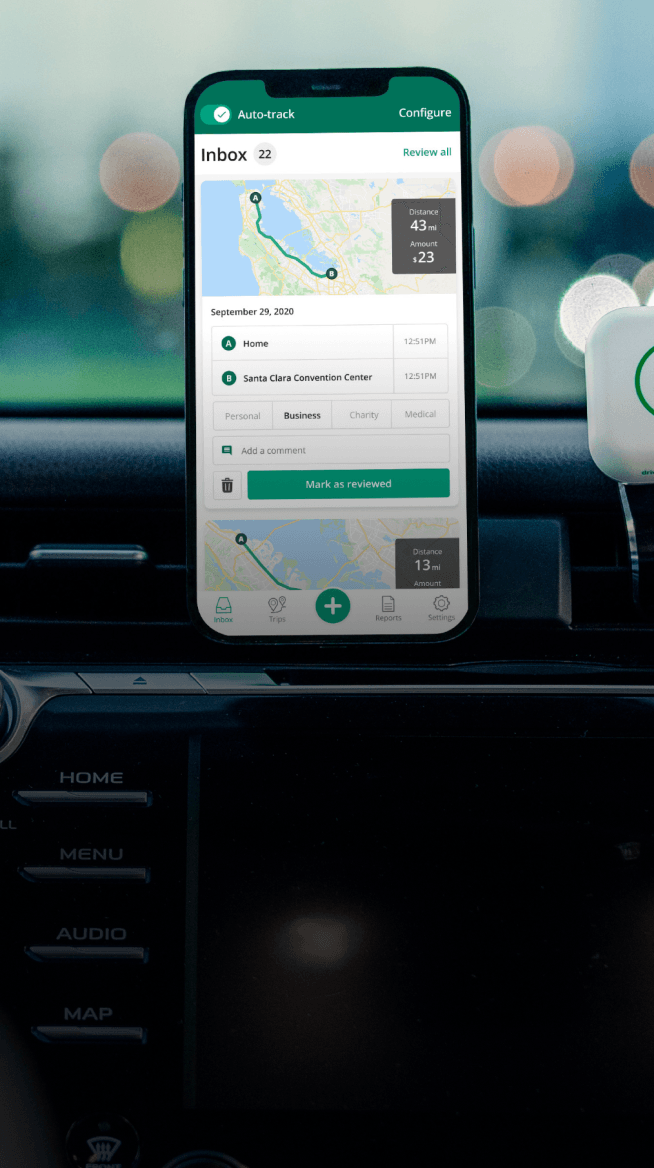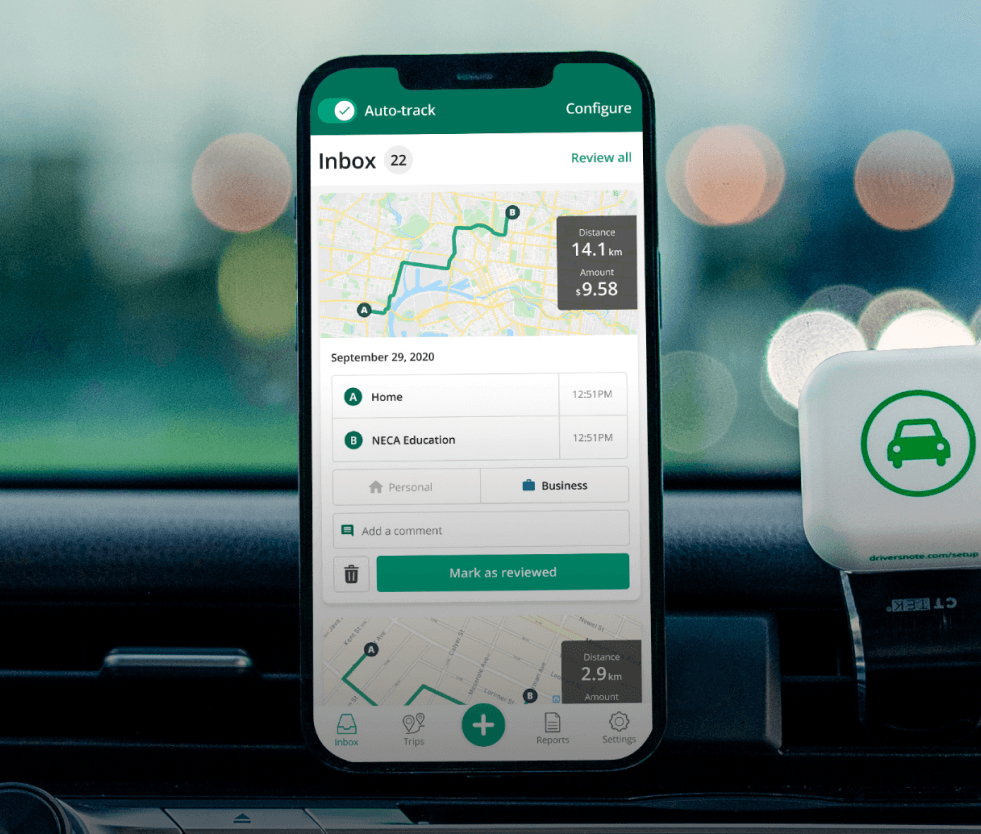Track mileage automatically
Get started
Company Mileage Reimbursement Guide
Company mileage reimbursement programs can greatly benefit your employees and are a powerful tool for your company. However, if not well-designed, they can also be a hassle and take up a lot of time and effort.
All the mileage tracking, trip logging, and reporting can seem like a burden, but you can take steps as an employer to ensure your company mileage reimbursement is streamlined and makes your employees happy.
Creating a successful company mileage reimbursement program is actually easier than you might think once you get a clear overview of the rules. Luckily, this guide will help you do just that! For a general US mileage reimbursement overview, you can check out our IRS mileage guide.
Company mileage reimbursement explained
Company mileage reimbursement is most commonly a cents-per-mile allowance to employees to cover their personal automobile costs incurred as part of their job.
The IRS has set the company mileage reimbursement rate in 2025 at 70 cents per mile. The 2024 mileage rate was 67 cents per mile driven for business use.


Mileage tracking made easy
Trusted by millions of drivers
Automate your logbook Automate your logbook

Automatic mileage tracking and IRS-compliant reporting.
Get started for free Get started for freeHow to calculate mileage reimbursement
Company mileage reimbursement is calculated by multiplying the standard mileage rate (or the alternative rate you use) by the miles driven over a payment period. Let's say your employee drives 1000 miles in January 2025. Then, they receive $0.70 per mile when you use the standard company mileage rate for 2025.
Also read: How To Calculate Your Mileage Reimbursement
Remember that your employees must document and record their mileage. It's easily done with a business mileage log, which is a log of all the business and personal trips an employee takes with their personal vehicle.
What does company mileage reimbursement cover?
Operating a vehicle for business purposes incurs considerably more costs than just gas. The list of expenses that are covered is extensive. Oil, tires, taxes and registration, maintenance, and auto insurance are all included.
Employees’ vehicle costs may be higher than you think - consider the average cost of owning a vehicle in your area. Providing a higher or lower reimbursement than the standard mileage allowance rate is possible.
You are not obliged to use the IRS mileage rate
It is common for companies to use the standard rate. However, it is not mandatory. The IRS recommends the standard rate, and it may be a perfect fit for your company, but you are not obligated to use it.
You may wish to raise your rate if you do business in an area where fuel and tolls are more expensive. If you choose a rate that is higher than the federal rate, however, every additional penny will be taxed as income to the employee.
If you operate in a less expensive area, you may want to consider using a lower rate. The standard mileage rate is calculated using changing national averages and may not fit all states perfectly.
What if the company doesn’t have a mileage reimbursement program?
If employees are not reimbursed for their business-related mileage, they can claim a tax deduction at the IRS mileage rate for each mile they’ve driven for business at tax time.
How is company mileage reimbursement done?
Proper mileage reimbursement involves several steps. The two most important things your employees should do are properly track their mileage and provide sufficient records of their business miles.
Tracking business mileage
Employees must prove that they have driven the business miles for which they claim reimbursement. One way to get that proof is by tracking mileage for each trip with a business mileage tracker. If setting up a mileage reimbursement program interests you, you may want to consider setting a standard way in which everyone in the company tracks their mileage. That way, mileage records will be generated quickly and seamlessly.
GPS mileage tracking is common nowadays and part of any modern mileage tracking app out there. Some apps also offer automatic business mileage tracking, which saves you and your employees time. Driversnote offers this option through the use of our iBeacon device, which automatically tracks all your business trips.
Records for company mileage reimbursement
The IRS sets the rules for what is considered a compliant mileage log. The mileage record serves as proof for showing the IRS or the employer that employees have driven the miles they claim reimbursement for. The following is what a compliant mileage log must include.
- The time and date of each journey.
- The total distance covered (odometer readings can be useful for noting business miles).
- The destination of each drive.
- A description of the purpose.
Try our free mileage log template.
Reimbursing employees for company mileage
If your employees log their driving, then reimbursement should be a breeze. We will quickly guide you through reimbursement if you or your employees use the Driversnote mileage tracking app.
- The first step is to ensure that everyone has downloaded the mileage app and received a quick setup introduction on the Driversnote help center.
- Make sure everyone understands how to track and log their trips.
- Let’s assume your company requests a trip report at the end of each month. In that case, the employees could quickly generate a report and share it directly with their supervisor or the financial team.
- Lastly, the person responsible for reimbursement approves or rejects the reports and reimburses the employees. Employees can receive reimbursements in their next paycheck, as a separate check, or through direct deposit into their bank account.
If you have the right tools, company mileage reimbursement does not have to be a hassle. Migrating from paper logbooks to using a mileage app can save your company a lot of time and effort.
FAQ

Tired of logging mileage by hand?
Effortless. IRS-compliant. Liberating.
Top posts
Related posts
Free IRS Mileage Calculator
Latest update: December 1, 2025 - 2 min read
Use IRS mileage rates or set your own. Simply enter how many miles you drove to calculate your mileage reimbursement or deduction.
Employees’ Guide To Car Allowance
Latest update: February 24, 2025 - 2 min read
Learn how a car allowance can help you purchase, repair, and maintain your vehicle. Everything employees need to know about getting a car allowance in 2025.
IRS Mileage Guide
Latest update: April 24, 2025 - 10 min read
Mileage reimbursement in the US — rates and rules for employees, self-employed and employers in the US.

.svg)
